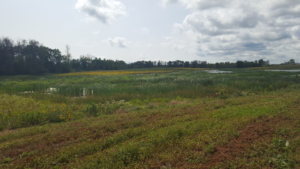
Unearthing Remnant Sedge Meadow Restores Lost Wetland Functions
Author: Matthew C. Parsons, M.S. (Senior Ecologist – Eco-Resource Consulting, Inc.)
The B. Bruce Krier Conservancy (Conservancy) – located in the Town of Belgium, Ozaukee County, Wisconsin – is a true conservation success story. It exemplifies what is possible with a clear, strong vision; dedication to a collaborative approach; and reliance on practical scientific expertise. The Conservancy’s mission is “to restore and preserve the ecological value of their land holdings, promote a responsible land stewardship ethic, and provide an immersive outdoor classroom for students of all ages to experience a diverse natural area.”
The approximately 445-acre Conservancy is composed of large tracts of restored tallgrass prairie; restored wetlands; forested wetlands, woodlands; agricultural fields; grassed waterways; and homestead/tree-lines. Most of the wetlands in the Conservancy are located on the Sucker Creek floodplain.
Prior to restoration, the wetland complex was of relatively low quality and dominated by reed canary grass (Phalaris arundinacea). Soils investigations conducted by Eco-Resource Consulting Inc. (ERC) during the project’s planning phase revealed a layer of remnant organic peat (Houghton muck) that had been buried over time by up to 24 inches of colluvium, indicating the presence of a relict sedge meadow. Years of agricultural practices in the region resulted in the gradual deposition of mineral sediment on the Sucker Creek floodplain, burial of the remnant sedge meadow, and the subsequent colonization of invasive reed canary grass. To ERC ecologists, the restoration strategy was clear: remove the top two feet of mineral sediment from the Sucker Creek floodplain to unearth the original wetland surface; excavate shallow floodplain scrapes to enhance wildlife habitat, increase flood water storage, and increase nutrient attenuation; revegetate the shoreline and floodplain with various planting zones composed of a diverse array of native species; and restore previously cropped upland areas surrounding the floodplains to native prairie buffer.
Wetland restoration was completed in 2013 while restoration of the upland prairie buffers was completed the following year. Formal vegetation monitoring began in 2014 with meander surveys and transect/quadrat monitoring. Additionally, pre-restoration (baseline) species inventory data of Sucker Creek was collected by ERC in 2011. This allowed for a pre- versus post-restoration comparison of species richness and floristic quality. Key findings from vegetation monitoring of the restored wetland and prairie areas are as follows:
- Native species richness increased from 23 native species in 2011 to 102 native species in 2017.
- Native Mean Coefficient of Conservatism (Mean C) – a measure of a native plant community’s average disturbance tolerance, where 0 is high disturbance tolerance and 10 is low to no disturbance tolerance – increased modestly from 3.3 in 2011 to 3.7 in 2017.
- Native Floristic Quality Index – a measure of the overall floristic quality of the native plant community – more than doubled from 15.6 in 2011 to 36.9 in 2017.
- Relative cover of native species in the wetland restoration area was 75.3% in 2017, up slightly from 73.8% when this variable was previously measured in 2014. Relative cover of native species in the upland prairie buffer restoration area was 78.3% in 2017. 2017 was the first year relative cover was measured in the upland prairie buffer restoration areas.
These data point to the middle stages of recovery of a previously degraded wetland complex, but perhaps more interesting is the recruitment of native species that were absent from ERC’s seed mix or plant palette. The primary source of propagules from non-seeded species is likely populations located upstream or upwind of the restoration site; however, establishment from the latent seed bank is also an important factor. ERC found that half (50%) of the native species documented at the Conservancy in 2017 were not actively planted, though it should be noted that these species exhibit a wide range of Coefficient of Conservatism values and includes some weedy, opportunistic natives. In addition to the relatively abundant, showy native wetland species such as blue lobelia (Lobelia siphilitica), cardinal flower (L. cardinalis), and New England aster (Symphyotrichum novae-angeliae) that were actively installed by ERC, naturally recruiting highly conservative species such as shrubby cinquefoil (Dasiphora fruticosa), Ohio goldenrod (Solidago ohioensis), and beaked spike-rush (Eleocharis rostella) have also been observed at the Conservancy. No voucher specimen was collected on the putative beaked spike-rush observation, but follow-up surveys will be conducted to confirm the presence of this State-threatened spike-rush.
ERC’s observations are not necessarily earth-shattering, but they lend further support to the need for restoration projects to address the root cause of ecosystem decline (in this case conventional agricultural practices leading to water quality degradation, sediment deposition, and invasive species colonization) as opposed to simply treating the symptom. The process of excavating the mineral soil overburden and physically removing reed canary grass restored numerous critical wetland functions: reconnecting the creek to its floodplain and restoration of a more natural hydrologic regime, creating areas for floodwater and excess nutrients to attenuate, improving water quality by removing a large source of nutrient-laden sediment, unearthing suitable organic soil substrate for a diverse assemblage of native species to re-colonize, and, as a bonus, allowing for the passive restoration of the latent seedbank.
ERC recently presented a poster titled, “Restoring Remnant Sedge Meadow Along Sucker Creek – B. Bruce Krier Conservancy, Ozaukee County, WI” which summarized the latest vegetation monitoring data from the Conservancy. The poster, presented at both the 2017 Southeastern Wisconsin Conservation Summit held in Port Washington and the 2018 Wisconsin Wetlands Association Conference in Lake Geneva, was well-received by attendees.
Ongoing maintenance issues at the Conservancy include recent expansion of non-native, Eurasian, cool season grasses into the restored upland prairie buffer areas. ERC is planning spring burns and well-timed broadcast herbicide application to help keep these undesirable species at bay. Controlling reed canary grass is also an ongoing maintenance need.
ERC regularly hosts volunteer events at the Conservancy, which include native seed collection days, native wetland plant installation days, and educational tours. Anyone who is interested in getting involved at the Conservancy or would like more information on services provided by Eco-Resource Consulting, Inc. should contact Matt Parsons by email, mparsons@eco-resource.net or by phone at (608) 877-9372 ext. 403.


